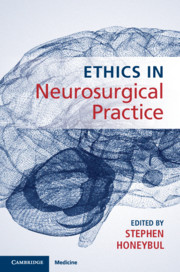Book contents
- Ethics in Neurosurgical Practice
- Ethics in Neurosurgical Practice
- Copyright page
- Contents
- Contributors
- Introduction
- Part I General Ethics
- Part II Neurosurgery-Specific Bioethics
- Chapter 10 A Historical Overview of Ethics in Neurosurgery
- Chapter 11 Evidence-Based Neurosurgery: Principles, Applicability, and Challenges
- Chapter 12 Ethical Challenges of Neurosurgical Care for Brain Tumour Patients
- Chapter 13 Severe Traumatic Brain Injury
- Chapter 14 ‘Malignant’ Middle Cerebral Artery Infarction
- Chapter 15 Aneurysmal Subarachnoid Haemorrhage
- Chapter 16 Paediatric Neurosurgery
- Chapter 17 Spinal Neurosurgery
- Chapter 18 Ethical Challenges in Psychosurgery: A New Start or More of the Same?
- Chapter 19 Brain Death and Organ Donation
- Part III Future Developments
- Index
- References
Chapter 13 - Severe Traumatic Brain Injury
from Part II - Neurosurgery-Specific Bioethics
Published online by Cambridge University Press: 29 May 2020
- Ethics in Neurosurgical Practice
- Ethics in Neurosurgical Practice
- Copyright page
- Contents
- Contributors
- Introduction
- Part I General Ethics
- Part II Neurosurgery-Specific Bioethics
- Chapter 10 A Historical Overview of Ethics in Neurosurgery
- Chapter 11 Evidence-Based Neurosurgery: Principles, Applicability, and Challenges
- Chapter 12 Ethical Challenges of Neurosurgical Care for Brain Tumour Patients
- Chapter 13 Severe Traumatic Brain Injury
- Chapter 14 ‘Malignant’ Middle Cerebral Artery Infarction
- Chapter 15 Aneurysmal Subarachnoid Haemorrhage
- Chapter 16 Paediatric Neurosurgery
- Chapter 17 Spinal Neurosurgery
- Chapter 18 Ethical Challenges in Psychosurgery: A New Start or More of the Same?
- Chapter 19 Brain Death and Organ Donation
- Part III Future Developments
- Index
- References
Summary
For many years, the management of severe TBI has been based on information gained from intracranial pressure (ICP) monitoring. The rationale for its use is based on the three Ps of prognosis, perfusion, and pathology of TBI, with the hope that using ICP to guide therapy would prevent secondary brain injury and ultimately improve neurological outcome.However, one of the fundamental challenges in neurotrauma has been the inability to demonstrate that the fall in ICP achieved by these measures is subsequently translated into an improvement in clinical outcome. For years, patients with severe TBI were routinely hyperventilated, frequently placed in a barbiturate coma, or more recently rendered hypothermic, because these measures consistently reduce intracranial pressure. However, clinical studies have failed to show that lowering intracranial pressure by these techniques provides clinical benefit, and in some instances they may have caused harm. It is this regard that the use of decompressive craniectomy was thought to be promising, and there have now been two large multicentre randomised controlled trials investigating efficacy of the procedure. The results provide good evidence to guide practice but also raise ethical issues regarding the use of a procedure that reduces mortality but increases survival with severe disability.
- Type
- Chapter
- Information
- Ethics in Neurosurgical Practice , pp. 121 - 133Publisher: Cambridge University PressPrint publication year: 2020



